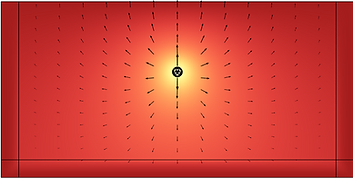top of page

Giglio Power Infrastructure Engineering
Advancing Power Infrastructure
(Click any of the images for more information about the application)
Typically, all three modes of heat transfer (conductive, convective, and radiative) are modelled. We can use IEC, IEEE, NEC equations in our simulations for heat sources or we can couple with electromagnetic physics to compute and use the losses in true Multiphysics coupling. Approximations are avoided and the full Navier-Stokes equations is solved to obtain one unified solution among all the physics.
Power cable modeling and ampacity calculations is a rare specialty that only a few engineers have the proper education and experience to be able to professionally consult clients. We have the verifiable expertise and strong qualifications in this area and this is what sets us apart from the competition. Having an engineering degree or title is not enough. This is a complex Multiphysics discipline that requires understanding of how heat is generated electromagnetically, and how heat is transferred safely to be able to ensure designs and calculations are accurate (See the table below).
In 2022 we published our online IEEE early access version of our paper "Dynamic Thermal Model for Different Size Trefoil Power Cables With Various Loads in Non-Forced Ventilated Tunnels" where we showed how to directly compute power cable ampacity and compute emergency load transfers. Stay tuned for the paradigm shift that we are going to cause in transient ampacity calculations in 2025.
See the table below to understand why electrical engineers make the best thermal engineers to model power cables and compute power cable ampacity for custom designs.

Utility Tunnels
Utility tunnels is an alternative to running transmission and distribution power lines overhead. The obvious advantage of using utility tunnels is the protection it provides to power cables.
Only simple power cable installations can be modelled analytically using standards (IEC, IEEE) and codes (NEC). The main challenge with designing power cable systems for utility tunnels is computing the thermal resistances and capacitances of the soil external to the tunnel. The soil may have thermal properties that are non-uniform and soil migration may occur in the thermal system.
Fortunately, we have in depth knowledge and expertise modeling power cables in tunnels using COMSOL Multiphysics to compute the ampacity for any number of cable, various types and loads, and for any cable operation.

Directly Buried
A single three-core cable may be installed directly buried in the ground. This is not a complicated installation but computing the thermal resistance and capacitance of the filler in the cable is challenging. However, using a FEM simulation with COMSOL Multiphysics is very useful to compute these parameters and obtain a reliable power cable ampacity solution.

Ducts in Troughs
Power cables in ducts in a trough with top open to air is another non-standard installation. We are prepared to work with any installation complexity and determine ampacity for any cable operation including load transfers and cyclic loading.

Cable Trays
Power cables in trays is a typical installation frequently used to distribute power within a facility such as a university, hospital, military base, commercial building. Typically, they run on rooftops, basements, utility rooms, etc., and different sections may be exposed to different environments. Selecting the proper cable tray size for the number of cables and the required load is an optimization problem. We have experience helping clients with this kind of application.


Forced Ventilated Troughs
Forced ventilation can be used in cable systems to cool cables so that higher ampacity values can be obtained. We have experience helping clients from utility companies determine what is the required inlet velocity to achieve a desired outlet velocity in the fully developed region. Also, we have experience computing and/or verifying ampacity values used in forced ventilated systems.
The Reynold's number must be computed to determine if the fluid flow regime is laminar or turbulent. Furthermore, the entrance length in the inlet region must be sufficiently meshed up to the fully developed flow region. Symmetry can be taken advantage of to reduce the model size. COMSOL Multiphysics makes it easy to model any complex installation, even long trough runs, and the post processing tools it provides makes it very intuitive to analyze results.
bottom of page









